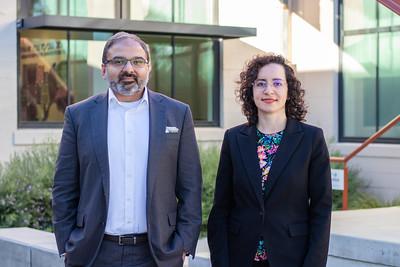When Quantum Systems Combine
UC Partnership in Computational Transformation and UC Multi-Campus Research Programs and Initiatives Grants Support Advancement of Quantum Sciences
Two teams of researchers led by Marina Radulaski, assistant professor of Electrical and Computer Engineering, recently won University of California grants that promise to give scientists a better understanding of quantum information sciences—a rapidly-emerging technology that stands to transform the way society interacts with computers and technology.
One of the competitive grants, called the 2022 UC Partnerships in Computational Transformation, supports novel breakthroughs and innovative approaches in quantum sciences that are only possible with cross-discipline, cross-campus team approaches. The UC Davis team won the accelerated scientific discovery in quantum computing grant, which will allow them to forge a formal partnership with UC Berkeley and have access to a quantum computer at the Lawrence Berkeley National Laboratory, or LBNL, Advanced Quantum Testbed facility.
Connecting multiple areas of quantum information sciences
Radulaski's team will be able to do modeling of her lab’s focus, quantum nanophotonics, using a quantum computer with Irfan Siddiqi who is the director of the LBNL quantum testbed, professor of physics at UC Berkeley and co-PI on the project.
This collaboration is so significant that is has already generated other new programs that also garnered grant funding. The new, pilot program that Radulaski is leading is called CIRQIT, or Collaborative Interdisciplinary Research in Quantum Information Topics. The CIRQIT program was recently selected as the recipient of a University of California Multi-Campus Research Programs and Initiatives award.
In this project, Radulaski and Siddiqi will partner with UC Santa Cruz Professor of Chemistry Yuan Ping, UC Merced Professor of Physics Lin Tian, and UC Davis Professor of Physics Richard Scalettar. The CIRQIT project aims to strengthen the quantum information research ties between northern California UC-campuses and expand on STEM training opportunities for a diverse set of students. Moreover, the impact of the program directly aligns with the goals of the National Quantum Initiative Act in increasing U.S. technological and economic international competitiveness.
Simultaneously advancing quantum innovations

“The great thing, in both these projects, is that we are combining expertise from multiple areas of quantum information. The Berkeley team has expertise in quantum nanoelectronics, which build these computers. At UC Davis, we have expertise in quantum nanophotonics and correlated quantum matter. UC Merced and UC Santa Cruz bring expertise in solid state quantum computing and ab initio (from the beginning) studies,” she said. “By combining them, we can create something new. Basically, cohesion between different areas so we can simultaneously advance them all.”
Quantum computing
Quantum computing is a rapidly emerging technology that harnesses the laws of quantum mechanics to solve problems too complex for classical computers. Instead of using ones or zeroes like traditional computers, quantum computers use ones, zeroes or varied degrees of both.
This added dimension makes the computer much more powerful and opens huge potential for new innovations for everything from drug delivery to climate change to military defense. For that reason, there is an ever-growing global race by companies and governments alike to learn more about quantum information systems.
Quantum nanophotonic use quantum systems to study light and matter interactions at the nanoscale. A better understanding of how light and matter interact in the quantum realm could have “broad technological applications,” according to Radulaski.
She added, “We are doing all this so that the next generation of hardware for quantum computers can have better components that could help us transmit information more securely across long distances, or even create a quantum internet.”
Student researchers work with national lab
Radulaski added that the grants will also present valuable opportunities to graduate and undergraduate students.
“My students will have a chance to interact with external collaborators at a national lab,” she said. “And that will be very important for their overall training and development as professional researchers.”
A “sizzling time”
Having access to these small, “next generation of computers” that exist at LBNL is “a very rare resource to find,” says Radulaski. In 2018, only 11 quantum computers existed in the world, but that number has grown rapidly.
The scientific potential of these projects, as well as UC Davis’ efforts to establish a leadership role in this innovative, fast-growing technology that has huge societal implications makes these grants and projects extremely exciting, according to Radulaski.
“The next generation of computers is at this budding stage,” Radulaski said. “So, it’s really this sizzling time for all of us in computer engineering, physics, material science and related fields, to see what will come out of these research projects.”
